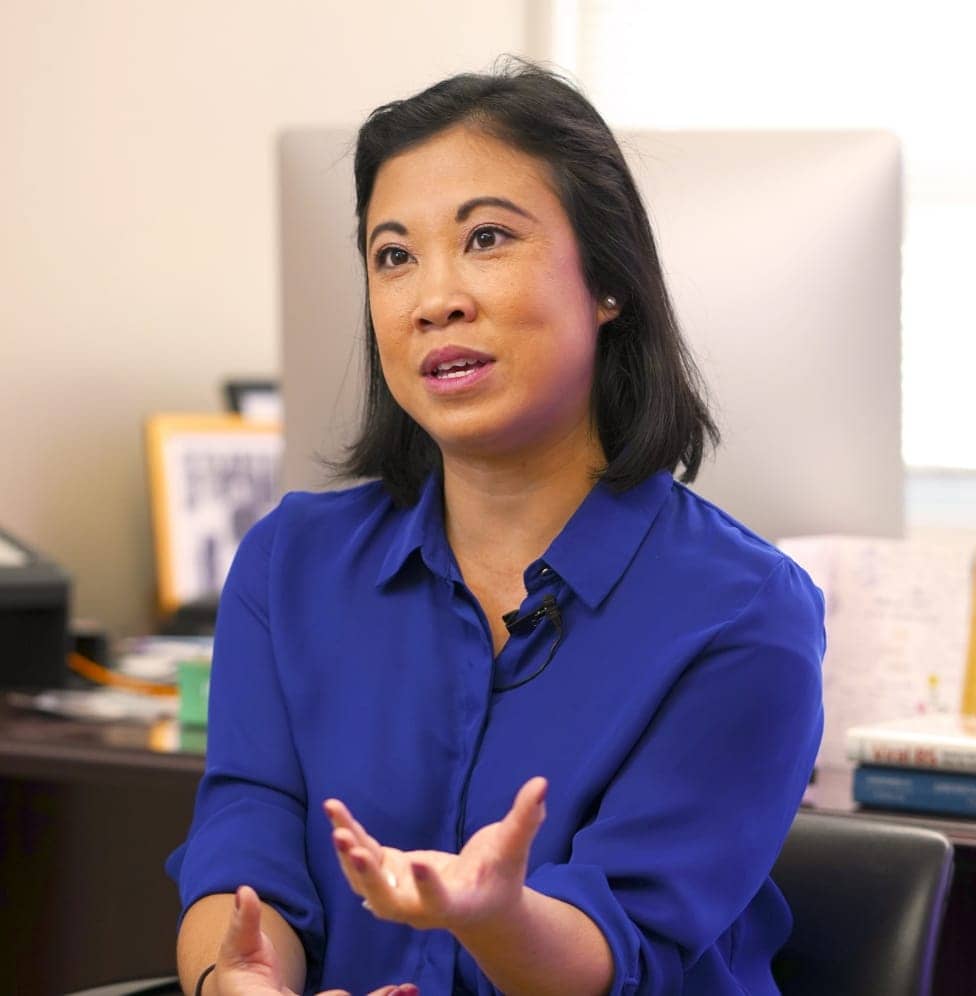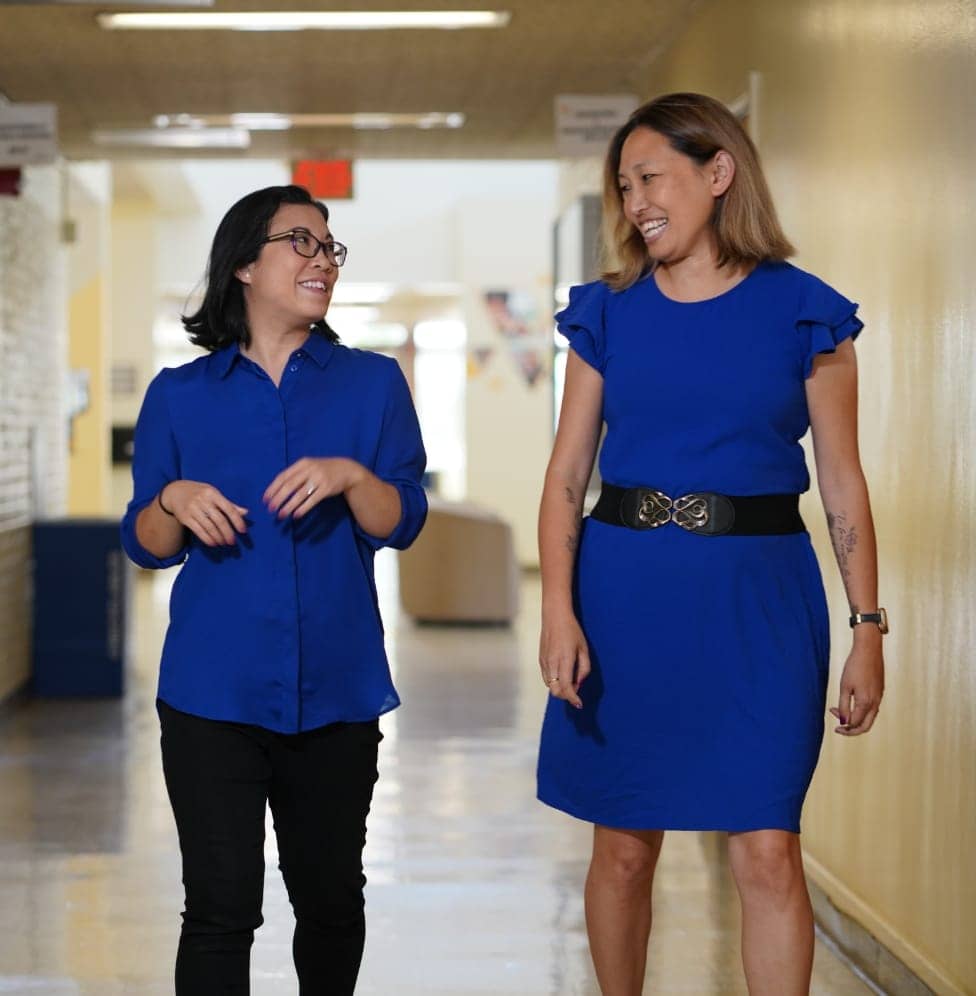
Identity in Focus
COLLEGE OF EDUCATION
Future teachers learn culturally responsive practices and develop deeply rooted professional identities.
Professor Dr. Betina Hsieh served as interim chair of the Teacher Education department at the College of Education during the 2022-to-2023 academic year. She is also the 2023 recipient of the Mid-Career Award in the Teaching & Teacher Education division from the American Educational Research Association (AERA). This annual award identifies an exceptional researcher in each of the association’s divisions who has produced a noteworthy body of research since earning their doctorate 10 to 16 years ago. The theme that runs through all of that research for Dr. Hsieh is teacher identity. “How we understand what teaching is supposed to look like helps us construct a professional identity, and then that professional identity guides the choices that we make in terms of our practice,” she says.
Just one example of that research focus is a groundbreaking book that Dr. Hsieh wrote with Dr. Jung Kim at Lewis University, The Racialized Experiences of Asian American Teachers in the US. This book uses Asian American critical race theory as a framework to examine what the Asian American educator’s experience is like. Asian Americans are underrepresented in general in educational research and are typically only researched in ways that perpetuate stereotypes of foreignness and “the model minority.” The book applies a different lens and looks at the experiences of these teachers. Dr. Hsieh and Dr. Kim interviewed 50 Asian American teachers nationwide as part of the research effort.
Dr. Hsieh is also working on a transnational project with her CSULB colleague Dr. Alejandra Priede that has internal funding from both institutions involved—the University of Bordeaux and CSULB. They are conducting a cross-cultural comparative study about teacher recruitment and retention, and the crisis discourse around teachers leaving the profession in both the United States and France. They adapted a survey that was given to teachers in France for teachers in the United States and fielded it among 1,000 teachers whose demographics roughly match the demographics of teachers in the United States. The results reveal that though the two countries have different histories and systems, they are seeing similar realities as the numbers of teachers who stay in the profession steadily drop in both countries. The study looks at parallel discussions in both countries around teaching no longer being a lifetime career or profession. “There’s this overwhelming sense of disrespect that teachers are really feeling that is pushing them out of the profession—and that is in both places,” says Dr. Hsieh. She says that these findings stress for her the importance of “listening to teachers and rehumanizing the profession.”
One of Dr. Hsieh’s most critical projects is funded by the Spencer Foundation. Dr. Hsieh received a $50,000 Spencer Conference Grant for a conference called Moments and Movements: Challenging Asian American Invisibility in Racial Justice in K-12 Education. Fifteen teachers and scholars from around the country took part in the grant initiative. The in-person conference session took place in July 2023, but the group has met virtually twice as well and also presented at AERA in April 2023. The conference is taking place at just the right time because high school students in the state of California will need courses in ethnic studies to graduate starting in 2030. Meanwhile, the Cal State University system will require these courses even sooner. The task for Dr. Hsieh and her colleagues is to prepare students in CSULB’s credential programs to teach these courses.
This conference brings together scholars to design a three-part framework. The first part of the framework investigates teacher identity, examining the educator’s positionality and identity as a teacher of Asian American studies and Asian American histories. The second part adapts and adopts critical curriculum frameworks around Asian American studies, and the third focuses on pedagogy, or the technique of teaching. The first part—teacher identity—is Dr. Hsieh’s area of focus, and it is woven into all of her research and all of her own curriculum.


According to Dr. Hsieh, a teacher’s identity can be formed with three types of orientations. Teachers draw from all of these orientations, but one or another orientation might be more central to each teacher’s identity. The first, the self-oriented identity, draws upon the teacher’s experience as a student. Many students seek their teaching credentials because they had a good experience in school and perhaps had a specific teacher they admired, so their notion of good teaching is what worked for them. This is a common orientation, or one that is central to many teachers’ identity. A second orientation focuses on what works in practice and is called strategy-oriented or classroom-oriented. A lot of policy is strategy- or classroom-oriented. The third category of orientation is based on theory or principle. This orientation gives the teacher a theoretical grounding that can inform the other types of identities. The theory- or principle-based identity is what grounds a teacher’s identity and makes the entire framework sustainable.
These concepts are part of the curriculum for students in the credential programs, in particular the secondary program. The goal is to push candidates to think about new and different ways to understand their own teacher identities and to be culturally responsive. The challenge is that professors like Dr. Hsieh only have a very short time to transform what students in the credential programs have learned about teaching after a lifetime of experiences in the classroom. Many credential candidates’ only model of classroom instruction is a traditional one that doesn’t take into account how students’ cultures and backgrounds may influence their learning experiences. Teacher educators have to model culturally responsive practices in the classroom to support teaching candidates in making these considerations throughout all of their instruction. “The way that we figured out how to do it was kind of taking components of this larger rubric [on culturally responsive and sustaining practices] and then putting them into each one of our classes and then making it part of our student teaching rubric,” says Dr. Hsieh.
To illustrate what this looks like, Dr. Hsieh points to the Caminos Project, a five-year program funded by a Department of Education Grant for Hispanic-Serving Institutions. Dr. Hsieh’s involvement in this project was integrating culturally responsive and sustaining pedagogies and practices into the classrooms at the College of Education. The project sought first to have a deep understanding of what those practices are and how they can be integrated into everything from assignments to student teaching. After four years of faculty inquiry, the college began transforming parts of the secondary credential program. Then, when the special education program needed revising because of new state standards, they applied the rubric developed as part of the project. Finally, they were able to accomplish some work in the multi-subject credential programs, bringing the work to all three initial credential programs at CSULB.
The objective for Dr. Hsieh is to transform the entire system of teacher education. A transformation that centers on culturally responsive and sustaining practices can be done at scale if it’s done systematically and if it’s done by people willing to pool their knowledge and experiences and work with communities. “When you do get a committed group of folks together, transformational change is actually possible in teaching and teacher education. That’s what I hope will eventually happen to our field, and to teaching, because teachers are amazing people,” she says.